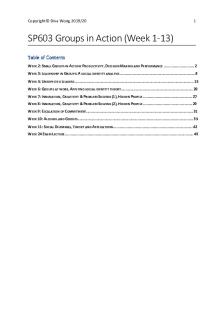Inertia In action demo - Proven Demonstrations PDF

| Title | Inertia In action demo - Proven Demonstrations |
|---|---|
| Author | Nicole Leckie |
| Course | Curriculum and Instruction in Secondary School Science |
| Institution | University of Victoria |
| Pages | 2 |
| File Size | 84.4 KB |
| File Type | |
| Total Downloads | 29 |
| Total Views | 132 |
Summary
Proven Demonstrations...
Description
EDCI 767 Physics Demonstration: Inertia in Action Possible Curriculum Contexts: Science 9 (Dynamics – Force), Physics 11 (Forces, Newton’s Laws), Physics 12 (Dynamics) Materials Needed:
Piece of paper (or tablecloth with no hem) Object (ie. book, cup, jar, etc.) Small piece of cardstock or thin cardboard (optional) Container with small opening (optional) Coin that fit in container opening (optional)
Directions:
Place the object on the piece of paper Ask the students what will happen if you slowly pull on the paper Slowly pull on the paper (the object will move with the paper) Ask the students what will happen if you pull the paper as fast as you can Pull the paper as quickly as possible (the object will stay where it was as you pull the paper out from under it)
Optional Addition
Place the small piece of cardstock over the opening of the container Place the coin on the cardstock, centred over the opening Ask the students what will happen if you pull quickly on the cardstock Pull the cardstock as flat and quickly as possible (the coin should fall into the container) Coin
Cardstock
Container
Safety Concerns: Be careful using breakable objects. If you don’t pull fast enough, they will move and potentially break.
Sample Questions for Students:
What caused the object to move when you pulled the paper slowly? Why didn’t the object move when you pulled the paper quickly? Is there a difference if a more or less massive object is used?
Explanation of the Effect: This demonstration is an example of inertia (the resistance of an object to change its state of motion) and Newton’s First Law (If no net force acts on an object, the object will maintain its state of rest or constant speed in a straight line.) Imagine a block on a ramp. If the force of gravity acting on the block is less than the force of friction between the block and the ramp, the block will stay still. If the force of gravity acting on the block is greater than the force of friction, the block will start sliding down the ramp. In this demonstration, you are moving “the block.” If the force of the moving paper is less than the force of friction between the object and the paper, the object will move with the paper. (The object stays still relative to the paper.) Pulling faster causes the force from the paper to be greater than the force of friction between the paper and the object. If the force of the moving paper is greater than the force of friction, the object will stay still. (The object slides off the paper.) In this case, the object feels no net force and therefore, inertia keeps the object stationary. Sample Lesson Directions: This demonstration is an excellent start for the first lesson on Newton’s First Law and the concept of inertia. Students could be asked to perform an experiment to see if there is a difference depending on the mass of the object. As well, they could investigate the effect of the coefficient of friction....
Similar Free PDFs

strategy in action
- 12 Pages

SP603 Groups in Action
- 50 Pages

Demo
- 9 Pages

C2010-530-demo - demo
- 5 Pages

QSDA2018-demo - QSDA2018-demo
- 5 Pages

Crime In Action - Portfolio
- 7 Pages

ACTION PLAN IN ENGLISH
- 4 Pages

ACTION PLAN IN SCIENCE
- 4 Pages

Electronic Government in Action
- 273 Pages

Evolution in Action
- 4 Pages

Psych in action
- 3 Pages

ACTION RESEARCH IN READING
- 34 Pages

E-Government in Action
- 195 Pages
Popular Institutions
- Tinajero National High School - Annex
- Politeknik Caltex Riau
- Yokohama City University
- SGT University
- University of Al-Qadisiyah
- Divine Word College of Vigan
- Techniek College Rotterdam
- Universidade de Santiago
- Universiti Teknologi MARA Cawangan Johor Kampus Pasir Gudang
- Poltekkes Kemenkes Yogyakarta
- Baguio City National High School
- Colegio san marcos
- preparatoria uno
- Centro de Bachillerato Tecnológico Industrial y de Servicios No. 107
- Dalian Maritime University
- Quang Trung Secondary School
- Colegio Tecnológico en Informática
- Corporación Regional de Educación Superior
- Grupo CEDVA
- Dar Al Uloom University
- Centro de Estudios Preuniversitarios de la Universidad Nacional de Ingeniería
- 上智大学
- Aakash International School, Nuna Majara
- San Felipe Neri Catholic School
- Kang Chiao International School - New Taipei City
- Misamis Occidental National High School
- Institución Educativa Escuela Normal Juan Ladrilleros
- Kolehiyo ng Pantukan
- Batanes State College
- Instituto Continental
- Sekolah Menengah Kejuruan Kesehatan Kaltara (Tarakan)
- Colegio de La Inmaculada Concepcion - Cebu


